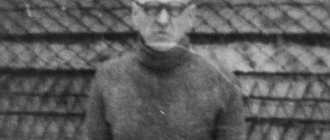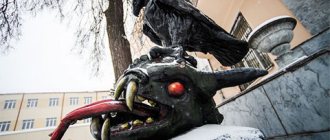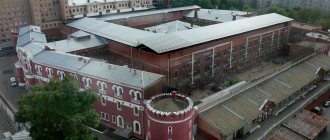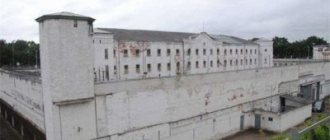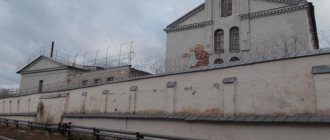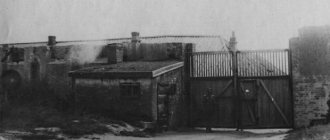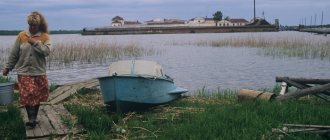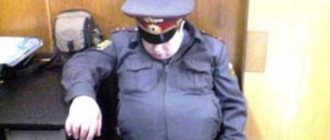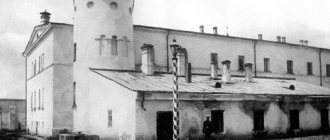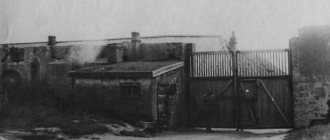Lenta.ru continues a series of publications about special regime colonies - the most terrible zones in Russia. There, in extremely harsh conditions, the most dangerous criminals are serving life sentences - from maniacs and cannibals to terrorists and creators of criminal gangs. In the previous article we talked about the Black Dolphin colony in the Orenburg region, and this time we will talk about the White Swan colony in the Perm region. Once upon a time, thieves in law were “broken” here, but today they are holding life-sentenced prisoners. They are separated from society by 15 security lines, 500 guards, 50 service dogs and guards who are ready to shoot to kill if they try to escape. Most will remain in the White Swan until the end of their days - and on the graves instead of a name there will be a number from a prison uniform.
Breaking thieves
In 1955, Usollag was abolished and in its place a regular colony for criminals appeared. In the early 80s, the correctional institution set a course for an active fight against the caste of thieves in law, which was annoying the authorities. The authorities were specially taken to Solikamsk, where they began to be painstakingly and mercilessly “processed.” This treatment took place inside a single chamber-type room (EPKT), which was specially erected on the territory of the colony as an experiment.
Various methods were used to “break” thieves - from outright intimidation and beatings to the use of all sorts of cunning moves. For example, after a medical examination, an authority figure could be told that he had been diagnosed with cancer, but in order to begin treatment, he would have to renounce his title as a thief. Or a particularly stubborn thief could be placed in a cell with “bitches,” renegades from the world of thieves who agreed to cooperate with the prison leadership. And the “bitches” were already trying to get their new neighbors to renounce their thieves’ titles.
According to unofficial data, over almost half a century more than 130 thieves in law have lost their titles in the White Swan. Vladimir Babushkin (Vasya Brilliant), a real legend of the world of thieves, who ended up in the colony, did not lose his title, but disappeared in the “White Swan” in 1985. Despite the fact that, according to the official version, the death of the authority was not violent, admirers of Vasya Brilliant are sure that he was killed for disobedience.
Thief in law Vladimir Babushkin (Vasya Brilliant)
Photo: Prime Crime
FSIN-STORE of products and goods for persons held in pre-trial detention centers, penal colonies, penal colonies, penitentiaries, prisons of the Federal Penitentiary Service of Russia
618545, Perm region, Solikamsk, st. Karnalitovaya, 98
About the institution.
Correctional institution FKU IK No. 1 (old name VK-240/1) OIK No. 2 of the Federal Penitentiary Service of Russia in the Perm Territory is a high-security correctional colony.
In correctional colony No. 1, persons serving their sentences for the first time to imprisonment for committing serious and especially serious crimes, those convicted of repeat crimes and dangerous repeat crimes. Under strict containment conditions, the filling limit is 1654 places.
In correctional colony No. 1 there is a single cell-type room (EPKT) with 46 places. In recent years, the special contingent of the correctional institution has changed, it has become younger, and the number of convicts entering the correctional colony with a low educational level, or even completely illiterate, is growing. Many convicts do not have a family, a permanent place of residence, and suffer from various diseases. More than half of them do not have any professional and labor skills or have lost them.
Correctional institution FKU IK No. 1 of the Federal Penitentiary Service of Russia in the Perm Territory has its own production. Much attention is paid to the labor adaptation of convicts. During the reform of the production sector of the correctional institution, the state unitary enterprise was transformed into the Center for Labor Adaptation of Convicts (CLAO).
The main type of production activity of the enterprise FKU IK No. 1 is: logging, woodworking, furniture production, manufacturing of souvenirs. In correctional colony No. 1, more than 70% of convicts are not employed, including those who have claims or pay alimony. The problem with jobs for convicts is being resolved slowly. This is due to the lack of qualified personnel, as well as the weak existing base for opening new types of production. Therefore, the search for orders to increase production volumes and increase the number of convicts brought to work is the primary task of the administration of penal colony No. 1.
General education is organized in correctional colony No. 1. Convicts under the age of 30 receive secondary (complete) general education at the educational and consultation center of an evening (shift) general education school. In the vocational school of a correctional institution, convicts are trained in working specialties that are in demand in the labor market. Obtaining a profession gives convicts the opportunity to find employment both at the Center for Labor Adaptation of Convicts of Correctional Colony No. 1, and after release from the correctional colony.
The administration of correctional colony No. 1 of the Federal Penitentiary Service of Russia in the Perm Territory attaches great importance to maintaining family and family ties of persons serving sentences in a correctional institution. For this purpose, “Open Doors Days” are held, when convicts who are positively characterized by the administration of the correctional colony can invite their family and friends to a meeting.
Mass cultural work is carried out with convicts, amateur art concerts are organized, and creative groups perform. Correctional colony No. 1 is visited by representatives of the regional prosecutor's office, the public monitoring commission for the Perm Territory, the Commissioner for Human Rights in the Perm Territory, and the heads of the regional Main Directorate of the Federal Penitentiary Service.
In penal colony No. 1, conditions have been created for convicts to engage in physical education and sports.
On the territory of correctional colony No. 1, the Church of Feofan, Bishop of Solikamsk, was built, where the care of convicted parishioners is carried out.
Swan song of prisoners
In 1999, the correctional institution was repurposed as a colony for life prisoners and received the official name - correctional colony No. 2 (IK-2) of the association of correctional colonies No. 2 (OIK-2) of the Federal Penitentiary Service (FSIN) in the Perm Territory. In October of the same year, the first 24 “lifers” arrived at the White Swan. They were placed in the EPKT, where thieves in law were previously “broken” - even during the initial design, all the cells in the room were equipped with strong double doors.
Solikamsk OIC-2, in addition to the White Swan itself, also includes correctional colony No. 1 (they have a common address). But, unlike IK-2, in IK-1 there are not life-sentenced prisoners, but ordinary prisoners with long terms of imprisonment. In addition, there are two colony settlements located near the White Swan.
Photo: Ruadvocate.ru
There are several versions of how IK-2 got its romantic “swan” name. According to one of them, the correctional facility was originally built in a clearing that local residents called the “White Swan.” According to another version, even during the break-up of thieves in law, the gates of the zone were decorated with figurines of swans - that is why this gloomy place began to be associated with noble birds. Finally, according to the third version, there are two white buildings on the territory of IK-2, and the curved paths leading to them resemble swan necks.
However, the prisoners themselves, who are in the colony, believe that the whole point is in the strict regime of detention, because of which their existence can be compared to a “swan song”. According to popular belief, it marks the end of the life of swans. However, there is one more, perhaps the most prosaic explanation. Prisoners are led around the territory of the colony bent over, with their arms shackled and pulled back - and their pose themselves somewhat resembles swans.
Be that as it may, over time the name “White Swan” has become a real prison brand of IK-2: convict craftsmen are actively making various things with a swan theme. For example, weather vanes, trash cans that prison authorities install on the territory, or wooden napkin holders in the shape of swans.
Life of special regime
Now in OIC-2, out of two and a half thousand convicts, there are about 300 “lifers”. They employ about 500 prison staff and 50 specially trained dogs. Jailers who want to get a job at the White Swan undergo a very strict selection process. They must have a higher education, good health, resistance to stress and an impeccable biography - not only for the applicant himself, but also for his immediate relatives.
In the White Swan cells, prisoners who received life sentences sit in groups of one, two or even three. Their compatibility is determined by a psychologist. For example, the Chechen field commander Salman Raduev was sitting with a former special forces officer: despite the fact that in the wild these two were supposed to become irreconcilable enemies, in the prison dungeons, as the psychologist had predicted, they were able to coexist quite peacefully.
Salman Raduev
Photo: Anton Denisov / TASS
In general, the daily routine of convicts in the White Swan is not much different from the routine in the Black Dolphin, the oldest Russian colony for lifers. General wake-up is at 6:00, followed by breakfast; Prisoners eat only in their cells. After breakfast, there is cleaning: all the belongings of the White Swan prisoners must be in a certain order, and there are cloth drawers in the cells for clothes.
Then the prisoners go to work, which is interrupted for lunch - at 13:00 - and a daily walk in the fresh air, which lasts 1.5 hours and takes place in specially equipped cells. Once a week prisoners are allowed to take a shower. Dinner is at 18:00, and after it until lights out, which starts at 22:00, there is free time. But at any moment a window in the cell door may open - and then the convict is obliged to jump up as quickly as possible, stand facing the wall and raise his hands with his fingers outstretched.
Twice a day (60 minutes each) prisoners of the White Swan can listen to the radio. In addition, they have the right to watch TV for 1.5 hours - but no one will buy it for their cell at government expense. To purchase them, either the convicts themselves save money from their own funds, or their relatives buy televisions for them.
Prison love
Meanwhile, some of those sentenced to life in the “White Swan” manage to create families: they get married right in the zone, having met their chosen ones through acquaintances or by correspondence. However, for some semblance of family life, a prisoner must first serve 10 years - and so that there are no complaints against him. If the conditions are met, the prisoner is transferred from special to more lenient conditions of detention and is allowed long-term visits, including with his wife.
Among the scarce types of recreation in the White Swan, reading is considered the most accessible and popular. The colony has a large library of five thousand books, from which every inmate can find something to his liking. And some of the convicts even manage to receive a higher education in absentia behind bars - all these things help prisoners not to degrade in the harsh conditions of the zone.
Shot: Vesti Perm ONLINE / YouTube
Despite all the severity, “White Swan” can be considered one of the most progressive colonies for lifers. It was there that prisoners first had the opportunity to receive help from a psychologist, meetings with whom take place in a special recreation room. There, prisoners can not only talk with a specialist, but also simply relax, watch TV and sit on a soft sofa and armchairs. After constantly being in cells with hard berths and wooden benches, prisoners value the opportunity to visit the rest room very highly.
Features of the prison
“White Swan” became the first prison to have a special psychologist’s office. By visiting this place, the prisoner can be sure that all his fears and experiences will not be disclosed. This approach improves the overall atmosphere.
If someone decides to work here, they will face a serious selection process. Firstly, if you don’t have a higher education, then you can immediately forget about serving here. Secondly, you need to have many useful skills and abilities, including strong psychological stability.
The security service will thoroughly check a potential candidate for the position, starting from early childhood and ending with life today. The activities of immediate and distant relatives will be thoroughly studied. In addition, special attention is paid to the health of the future employee.
The management built a sports complex especially for the working citizens here. It's not uncommon for people to gather for concerts. Also, some artists are invited to perform in the colony itself.
Hard workers in robes
Many of those convicted in Perm OIK-2 are employed in production: there is a large woodworking shop there. Most of the prisoners work there, not counting the especially dangerous ones and those whose health condition does not allow them to work. Prisoners, as a rule, do their work conscientiously - the tables, chairs, cabinets and other furniture they produce are in great demand in nearby settlements. This is quite understandable, because the products from behind bars are of high quality, but are inexpensive.
Among all prison professions, the most prestigious is cabinet maker: it is believed that only a very talented and diligent prisoner can become one. Such a master makes all kinds of boxes, figurines, chess sets and salt shakers from expensive types of wood. It is curious that prisoners who are prone to escape often end up in cabinet-making jobs. This is explained simply: their production is located in a remote basement with one exit, which is carefully guarded by jailers. In addition, the colony administration believes that creative work can distract convicts from criminal thoughts, including attempts to escape.
Frame: the film “Tango for ZK”
In addition to wood products, prisoners in OIK-2 make shoes, building materials and cinder blocks. And the most gifted of them even find their calling in painting - for this purpose the colony has an art workshop. All things and paintings made by the prisoners are sold in a small store next to the White Swan. For their work, convicts receive a salary, but for many, all of it goes to pay for compensation awarded to the relatives of the victims.
It is curious that “White Swan” partially supplies itself with food: on the territory of the correctional facility there is a glass greenhouse, erected by prisoners, where vegetables and herbs are grown. Inside there is a Russian stove, which is heated daily, and therefore tomatoes and cucumbers ripen in May. Everything grown in the greenhouse goes straight to the zone’s kitchen.
All these industries employ a variety of convicts, but not those who are serving life sentences. The latter work in special cells, usually three people each - they paint pictures, make crafts from wood, and sew clothes. But “lifers” still have to earn the opportunity to work - they need to behave approximately for several years, successfully pass testing by a psychologist and gain the approval of the colony leadership. The workplaces of life-sentenced prisoners are located on the second floor of their own building, and they are constantly under close video surveillance. “Lifers” are strictly prohibited from working with ordinary prisoners, which is quite justified, considering why exactly they must remain in the White Swan for the rest of their days.
Conditions of detention in the Solikamsk MLS
Prisoners are kept in small cells measuring 4.5 square meters. three people each. There are many solitary confinement cells in which criminals live without “neighbors.” All the windows in the cells are sealed with double steel bars, the doors are also steel, with a window that opens from the outside, through which food is passed.
The prisoner is escorted under escort - three people and one dog handler with a dog . When moving from one room to another, prisoners wear a special black bandage so that the route is not visible.
Next to each block, which includes two cells, there are characteristics of each prisoner in these rooms: their photographs, biography, crimes committed. This is done to better inform security workers.
The distribution of prisoners among cells is carried out in accordance with their psychological characteristics in such a way that disputes and conflicts do not arise.
Criminals are only allowed to shower once a week . Due to this, their detention cells smell very strong and disgusting, because of this, criminals begin to suffer from various terrible diseases. Criminals are prohibited from leaving the building anywhere. They wear the same dark colored clothes.
If the life of a prisoner ends for any specific reason, a telegram is sent to his remaining relatives with information about what happened. Within three days they must collect the body or respond to the telegram. If there is no answer, the prisoner will be buried in the local city cemetery. As a rule, most of the prisoners in the Solikamsk colony are buried in the local cemetery.
Schedule
| Climb | 6:00 |
| Physical exercise | 6:00-6:10 |
| Toilet and refilling of beds | 6:10-6:30 |
| Breakfast, turning on the radio | 6:30-7:15 |
| Turning on electrical outlets. prisoners can use a boiler, an electric razor, etc. | 7:15-8:00 |
| Morning check and inspection, turning off the radio | 8:00-9:00 |
| Medical checkup | 9:00-10:00 |
| Morning walk in a special cell, the length of which is several meters, personal time | 10:00-13:00 |
| Dinner | 13:00-14:00 |
| Cleaning the cells | 14:00-14:10 |
| Personal time, turning on the radio | 14:10-18:00 |
| Dinner | 18:00-19:40 |
| Evening check | 19:40-20:00 |
| Turning on the outlets | 20:00-21:30 |
| Preparation for sleep | 21:30-22:00 |
| Dream | 22:00 |
Nutrition
The food in the colony is good. There are three meals a day: breakfast, lunch and dinner. Sample dishes on the menu :
- soup/noodles/rassolnik/shchi/borscht;
- potatoes/pasta/buckwheat/rice;
- cutlets/meatballs/meat/dumplings;
- compote/juice/cocoa/tea;
- a piece of cheese;
- bread;
- oil, etc.
Every day it costs about 50 rubles to feed one prisoner. If desired, the convicted person can buy food at a local stall. The choice there is limited, but still different from the products they provide in the colony.
Prisoners do not eat in the cafeteria, but in their cells . Food is handed to them through windows in the doors.
Job
Those who are imprisoned for life are prohibited from working. The rest can be engaged in landscaping, painting, sewing or carving wood - the choice is small. Everything that is made by the hands of convicts (key chains, backgammon, salt shakers, boxes, etc.) is sold in a small store next to the colony.
The average salary of a prisoner in this colony is 10 thousand rubles . As a rule, they give part of this money to pay off claims of relatives of people killed at their hands.
Studies
Unlike other types of colonies, there is no training in a special regime colony. It is not possible to obtain higher or secondary vocational education remotely here. The only thing that is possible here is to study independently, read special books and notes.
Religious issues
There is a church on the territory of the colony, where the priest comes on weekends and holidays. Prisoners are allowed to attend church under escort in their free time.
Oddly enough, there are a lot of believers in prison. Many believed in the existence of God before coming to this place, while others believed in it after. Prisoners are not prohibited from having crosses, Bibles or other symbols of faith .
Entertainment and relaxation
Prisoners are allowed to visit the library, listen to the radio daily and watch television for several hours a day. The television program is chosen by the leadership of the colony; it completely excludes the content of violence and crime in the films.
Every day prisoners are taken for walks. Just not to the street, as in ordinary places of deprivation of liberty, but to special cells with bars. walking cameras are located on the roof of the building. Their length is approximately 5-6 meters. At the top of the cells there is a window with a view of the sky; clean and fresh air comes in from the street.
On holidays, various events are held for convicts , in which they themselves can take part.
Dates and visits
It is important to remember that the White Swan IK has different conditions of serving.
- Ordinary – a new prisoner ends up “by default” (if he is not transferred from another correctional facility for violating the rules).
- Lightened - for good behavior.
- Strict - for non-compliance with the rules and regulations of the White Swan.
In accordance with Article 125 of the Penal Code of the Russian Federation, prisoners in a colony:
- under strict conditions, it is allowed to have two short-term visits and one long-term visit during the year;
- for normal conditions – two short-term and two long-term;
- for easier conditions – three short-term and three long-term visits during the year.
Transfer of products and things
The transfer of parcels can be carried out during long-term and short-term visits, as well as on any other day in accordance with the work schedule of the colony.
- For normal conditions of serving in a special regime colony, it is allowed to receive three parcels or packages and three parcels during the year.
- For lighter conditions - four parcels and parcels and four parcels.
- For the strict ones – just one parcel and one parcel post for a year.
Punishment cell
If the instructions or regulations of the colony are not followed, as well as due to various types of violations, convicts may end up in a punishment cell or, in other words, a punishment cell. Here prisoners can be kept for up to 15 days. The food in the punishment cell is different from what is usually given. It is less tasty and not varied.
Black list
The most famous prisoner of the White Swan was the Chechen terrorist Salman Raduev - during the war in Chechnya, he actively supported the disgraced general Dzhokhar Dudayev. Raduev entered the White Swan in mid-2002, but died of internal bleeding in December of the same year. But even without him, there are enough convicts in the zone whose details of their biography make your blood run cold.
One of them is Denis Pischikov, nicknamed Ural Raskolnikov. A native of the Sverdlovsk region, Pischikov killed 13 (according to other sources - 14) pensioners for the sake of very small amounts of money. The serial killer dealt with all victims in the same way - he hit them on the head with an ax. The maniac committed his crimes in the Moscow and Vladimir regions from 2002 to 2003. Pischikov was detained thanks to the daughter of one of the victims, who survived a powerful blow to the head and identified the attacker.
Frame: the film “Tango for ZK”
“I felt sorry for the grandmothers, but I needed to live on something. I see my granny and I’m completely transformed. It’s as if a voice is telling me: take an ax and kill. Ahead of me, I saw a shadow that was leading me…” the serial killer told investigators.
Former nurse Maxim Petrov, nicknamed Doctor Death, also preyed on elderly people; he got into "White Swan" in 2003. As the investigation established, Petrov, under the pretext of caring for the health of pensioners, managed to give lethal injections to 11 elderly residents of St. Petersburg, whose apartments he then cleaned out. While investigating a series of murders, investigators noticed that all the murdered pensioners were on the list of those who underwent fluorography at the local clinic. Having set up ambushes in the apartments of the remaining patients on the list, the operatives managed to detain Petrov.
"I hate this life itself"
Another famous White Swan prisoner is terrorist Adam Tsurov. In 1999, when he was only 19 years old, Tsurov, together with his accomplices, organized a major terrorist attack on the central market of Vladikavkaz, the capital of North Ossetia. As a result of the explosion, 52 people were killed and about 300 were injured of varying degrees of severity. Tsurov got into “White Swan” when he was only 23 years old; He will never leave the colony again.
In contrast, Alexander Murylev, who grew up in the family of a Soviet army officer, was not a terrorist. He went down in the history of Russian crime as one of the first “black realtors”. In 1993-1994, Murylev killed eight lonely Muscovites, after which he sold their homes - he took advantage of the fact that in the “dashing” 90s, one power of attorney was enough to sell an apartment.
Murylev met Muscovites, who, as a rule, abused alcohol, and persuaded them to sell or profitably exchange their real estate. Having received the treasured power of attorney, the “black realtor” immediately dealt with the victims - strangled or killed with a speargun. Today Murylev, who fell into the hands of justice in the spring of 1994, is considered one of the old-timers of the White Swan.
Frame: the film “Tango for ZK”
But the “Russian Breivik” - former lawyer Dmitry Vinogradov - has been in prison relatively recently, since February 2014. In 2012, he shot his six colleagues in the central office of a large pharmacy chain. One of the motives for the terrible crime is considered to be unhappy love: Vinogradov liked his colleague, but the relationship between them never worked out. Before causing a bloodbath in the office, the future killer left a hateful post on his social network page:
“I hate human society and I hate being a part of it! I hate the meaninglessness of human life! I hate this life itself..."
Vinogradov easily got inside the office with a Vepr-12 carbine and a Benelli M3 shotgun - the metal detector frame at the security post simply did not work. After the words “Hello, colleagues,” he opened fire to kill. The security service managed to subdue Vinogradov. He was sentenced to life imprisonment and payment of compensation in the amount of 10 million rubles to the relatives of the victims.
Life Stealers
However, the list of famous inmates of the White Swan does not end there. At one time, the story of Voronezh resident Roman Altukhov caused a lot of noise. For the murder of a neighbor in 1999, judge Galina Zuevich sent Altukhov to jail for six years. Having received parole in 2003, the former prisoner decided to get even with the judge who imprisoned him. He waylaid Zuevich in the courtyard of her house, stabbed her in the back several times and cut the unfortunate woman’s face with a cross. For his daring crime, Altukhov was sent to the White Swan for the rest of his days.
Another “lifer” of the colony, Alexander Chaika, nicknamed the Fur Hunter, is responsible for the lives of four Muscovite women whom he robbed and killed from January 13 to February 12, 1994. The killer attacked his victims, dressed in fur coats, in the elevators of residential high-rise buildings. The detectives investigating the case were amazed at the brutality of the crimes: Chaika inflicted eight to 21 stabs on the victims.
The serial killer was detained in mid-February 1994 thanks to the vigilance of operatives from a group specially created to catch the maniac. At the exit from the subway, they noticed a suspicious guy, as if he was looking for his next victim. The operatives’ intuition did not disappoint: Chaika was taken while he was following a woman in an astrakhan fur coat.
Another life-sentenced prisoner from the White Swan, former representative of the Bashkortostan parliament in the Federation Council Igor Izmestyev, according to the court verdict, did not kill people himself. He eliminated unwanted members of the Kingisepp organized crime group (OCG). The trial of Izmestiev, which ended in 2010 with his life sentence, became very resonant. In 2021, the convict wrote a petition for pardon to the President of Russia, but it was rejected.
Do prisoners have the right to parole?
In the White Swan colony, prisoners who have served a 25-year sentence and during all this time have not received a single reprimand, observing the regime of the colony (Article 79 of the Criminal Code of the Russian Federation) have the right to parole. Most prisoners receive repeated comments about their behavior very often.
But nevertheless, there were several cases of early release from such MLS. No one from this particular colony has ever been released on parole. Features of parole for life prisoners :
A lot of different circumstances can interfere with parole . It is best to seek the services of a good lawyer.
Next you will see a photo of the IR:
No chance of escape
As in “Black Dolphin,” near the cells of “White Swan” there are photographs of the prisoners sitting there with descriptions of the crimes they committed - so that the jailers always remember who they are guarding. The “dossiers” of especially dangerous convicts prone to escape or hostage-taking are supplemented by circles, triangles and other figures painted in bright colors.
However, the majority of prisoners, on occasion, begin to assert: none of them is guilty of anything, they were all victims of a slander. The jailers, of course, don’t believe them. However, according to the recollections of the former head of the White Swan, Ashot Sargsyan, in his lifetime he met one inmate whose guilt he doubted. The prisoner was convicted of murdering his wife and had the right to apply for parole, but for this he had to admit his guilt. The convict categorically refused to do this and preferred to serve out his sentence to the end.
Photo: Federal Penitentiary Service
Of course, in theory, he could try to escape - but in the entire history of the colony, no one had succeeded in escaping in the White Swan. This is not surprising: prisoners are separated from their freedom by 15 security lines. Even inside the colony building, where life-sentenced prisoners are imprisoned, every 10 meters of the corridor is blocked off with lattice doors. But even if one of the prisoners decides to escape, they will immediately open fire on him to kill.
But they still tried to escape from the White Swan; the most famous and daring attempt occurred in 1992. Then a prisoner named Shafranov acquired a hand grenade, which was given to him by one of the corrupt jailers. With it, the prisoner came to the office of the head of the EPKT and, threatening with an explosion, demanded the release of his friend, a repeat offender Taranyuk, from his cell.
At first, the fugitives were lucky - they took one of the heads of the prison administration hostage and demanded the car. But the leadership of the colony decided to take the rebels by force. An explosion occurred... As a result, one of the law enforcement officers who arrived at the scene of the emergency and prisoner Taranyuk died. Shafranov's feet were torn off on both legs - and there are all kinds of rumors about his future fate. According to some sources, he was shot, according to others, he served 12 years, was released and became involved in religion, becoming a preacher.
Speaking of religion. On the territory of OIK-2, prisoners built a church where services are held on religious holidays. In addition, priests often come to the White Swan and talk with convicts about faith, life and death.
***
Due to the harsh conditions of the White Swan, natural deaths of prisoners there are not uncommon. Most often, their causes are chronic diseases and strokes. When this happens, the prison authorities contact the relatives of the deceased. They have the right to bury the body wherever they want. But if within three days after the death of the convict none of his relatives responded, the deceased is buried in the local Solikamsk cemetery - the same one where the legendary thief in law Vasya Brilliant found his final resting place.
Today there is a good monument on his grave, which was erected by admirers of the famous authority. But ordinary prisoners from the “White Swan”, whose bodies were not taken by their loved ones, after death are not even awarded a small tombstone with their first and last name. Instead, there is only a cross or a plate with the number that the prisoner received in the colony during his lifetime. He does not part with it even in the grave.
Feedback from the Department of Law Enforcement:
If you have witnessed an important event, you have news or an idea for material, write to this address:
[email protected] More interesting and surprising things can be found on our Instagram. Subscribe!
Reception of citizens and relatives
In the White Swan camp, citizens and relatives of convicts are received by the head of the colony or his deputies. Detailed information about the hours and operating conditions of the prison can be found on the official website of PKU IK-2. The rules are strictly regulated and do not change.
- Reception of citizens by the head of the colony every Wednesday for an hour from 15.00
- Deputy heads of the colony, reception from 11.00 on Mondays and Thursdays
- On weekends, a duty officer from among the colony workers is appointed to receive visitors. Calling hours from 8.00 to 17.00
- Reception of applications, premises for meetings with prisoners, places for transferring parcels operate according to a single schedule daily from 8.00 to 17.00, on Friday from 8.00 to 16.00
